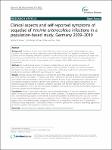Clinical aspects and self-reported symptoms of sequelae of Yersinia enterocolitica infections in a population-based study, Germany 2009–2010
Rosner, Bettina
Werber, Dirk
Höhle, Michael
Stark, Klaus
Background: Foodborne Yersinia enterocolitica infections continue to be a public health problem in many countries. Consumption of raw or undercooked pork is the main risk factor for yersiniosis in Germany. Small children are most frequently affected by yersiniosis. In older children and young adults, symptoms of disease may resemble those of appendicitis and may lead to hospitalization and potentially unnecessary appendectomies. Y. enterocolitica infections may also cause sequelae such as reactive arthritis (ReA), erythema nodosum (EN), and conjunctivitis. Methods: We studied clinical aspects of yersiniosis, antimicrobial use, and self-reported occurrence of appendectomies, reactive arthritis, erythema nodosum and conjunctivitis. To assess post-infectious sequelae participants of a large population-based case–control study on laboratory-confirmed Y. enterocolitica infections conducted in Germany in 2009–2010 were followed for 4 weeks. Results: Diarrhea occurred most frequently in children ≤4 years (95%); abdominal pain in the lower right quadrant was most common in children 5–14 years of age (63%). Twenty-seven per cent of patients were hospitalized, 37% were treated with antimicrobials. In 6% of yersiniosis patients ≥5 years of age, appendectomies were performed. Self-reported symptoms consistent with ReA were reported by 12% of yersiniosis patients compared to 5% in a reference group not exposed to yersiniosis. Symptoms consistent with EN were reported by 3% of yersiniosis patients compared to 0.1% in the reference group. Symptoms of conjunctivitis occurred with the same frequency in yersiniosis patients and the reference group. Conclusions: Acute Y. enterocolitica infections cause considerable burden of illness with symptoms lasting for about 10 days and hospitalizations in more than a quarter of patients. The proportion of yersiniosis patients treated with antimicrobial drugs appears to be relatively high despite guidelines recommending their use only in severe cases. Appendectomies and post-infectious complications (ReA and EN) are more frequently reported in yersiniosis patients than in the reference group suggesting that they can be attributed to infections with Y. enterocolitica. Physicians should keep recent Y. enterocolitica infection in mind in patients with symptoms resembling appendicitis as well as in patients with symptoms of unclear arthritis.
Dateien zu dieser Publikation
Keine Lizenzangabe

